Ladybird, ladybird, fly away home
Your house is on fire and your children are gone
All except one, and that's Little Anne
For she has crept under the warming pan.
Farmers and gardeners love ladybugs. If you have a garden of flower bed, these colorful insects will soon become your favorite.
Why? because they eat almost non-stop, and their favorite menu items are plant-eating insects, especially aphids. And so they help protect crops and flowerbeds. Ladybugs lay hundreds of eggs in the colonies of aphids and other plant-eating pests. When they hatch, the ladybug larvae immediately begin to feed. By the end of its three-to-six-week life, a ladybug may eat as many as 5,000 aphids.
The name “ladybird” originated in the Middle Ages when the insects were known as the “beetle of Our Lady.” They were named after The Virgin Mary, who in early religious paintings was often shown wearing a red cloak. The spots of the seven spot ladybird were said to symbolize seven joys and seven sorrows. Common names in other European languages have the same association (the German name Marienkäfer translates to "Marybeetle" or, literally, Mary-chafer). In the US the name was Americanized to "ladybug" In the Norfolk dialect of English, in the UK, a lady bird is known as a bishy bishy barnabee
A common myth is that the number of spots on the insect's back indicates its age.
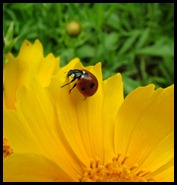
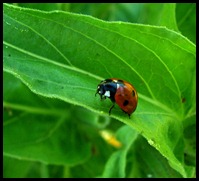 Their distinctive spots and red, yellow and black colors warn predators. This phenomenon is called aposematism. It works because predators learn to associate certain prey with a bad taste. Ladybugs can secrete a fluid from joints in their legs which gives them a foul taste. They can also play dead and pull their legs up “turtle-style” then release a small amount of blood from their legs – called reflex bleeding. The bad smell and the apparent look of death usually deters predators from a ladybug snack. After the threat of danger has passed, the ladybug will resume normal activities.
Their distinctive spots and red, yellow and black colors warn predators. This phenomenon is called aposematism. It works because predators learn to associate certain prey with a bad taste. Ladybugs can secrete a fluid from joints in their legs which gives them a foul taste. They can also play dead and pull their legs up “turtle-style” then release a small amount of blood from their legs – called reflex bleeding. The bad smell and the apparent look of death usually deters predators from a ladybug snack. After the threat of danger has passed, the ladybug will resume normal activities.
 In parts of Northern Europe, tradition holds that a person’s wish is granted if a ladybird lands on them. In North America, children capture a ladybug, make a wish, and then “blow it away” back home to make the wish come true. In central Europe, it is considered good luck. A ladybird crawling across a girl's hand is thought to mean she will get married within the year. Some cultures refer to ladybugs as fortune bugs. In Russia, a popular children's rhyme exists with a call to fly to the sky and bring back bread. In Denmark, a ladybird or mariehøne (“Mary's hen”), is asked by children to fly to our lord in heaven and ask for fair weather in the morning'.
In parts of Northern Europe, tradition holds that a person’s wish is granted if a ladybird lands on them. In North America, children capture a ladybug, make a wish, and then “blow it away” back home to make the wish come true. In central Europe, it is considered good luck. A ladybird crawling across a girl's hand is thought to mean she will get married within the year. Some cultures refer to ladybugs as fortune bugs. In Russia, a popular children's rhyme exists with a call to fly to the sky and bring back bread. In Denmark, a ladybird or mariehøne (“Mary's hen”), is asked by children to fly to our lord in heaven and ask for fair weather in the morning'.
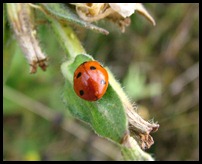 While there are male and female ladybugs, it’s nearly impossible to tell them apart. Females are usually larger than males. If you catch them mating, you will see a male ladybug grab hold of the female's elytra (hard wings) and holds on tight.
While there are male and female ladybugs, it’s nearly impossible to tell them apart. Females are usually larger than males. If you catch them mating, you will see a male ladybug grab hold of the female's elytra (hard wings) and holds on tight.
Because of its bold colors, simple shape and non-threatening nature, the ladybug has become the logo for a wide range of organizations and companies including:
- Symbol of the Dutch Foundation Against Senseless Violence
- Ladybird Books
- Ladybird children's clothing sold in the UK by the defunct Woolworth's chain store
- Polish supermarket chain Biedronka
- Estonian mobile operator EMT
- Software development firm Axosoft.
- Symbol of the Finnish Swedish People's Party.
The ladybug is the state insect of Delaware, Massachusetts, New Hampshire, New York, Ohio, and Tennessee, though only New York has selected a species native to the United States (Coccinella novemnotata); the other states have all adopted an invasive European species (Coccinella septempunctata).
Ladybird, ladybird, fly away home . . .

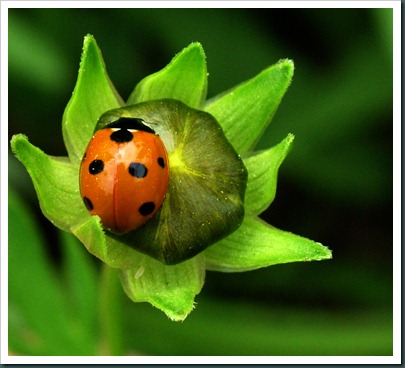
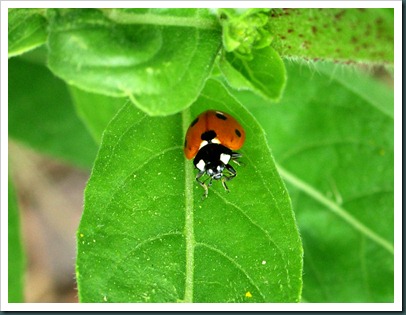
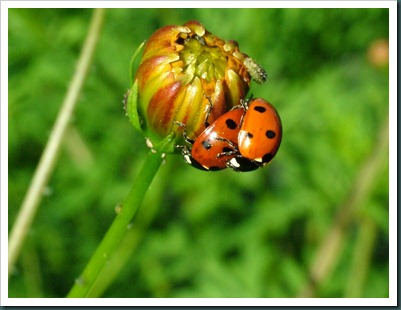
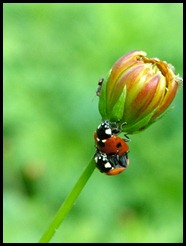
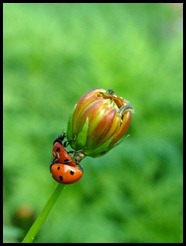
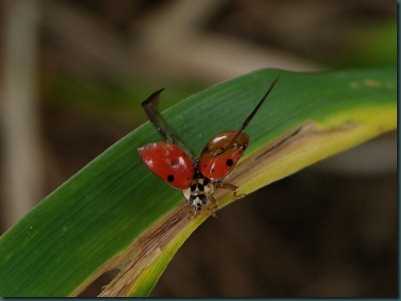
11 comments:
I´m always happy to see a lady bug in my garden. Normally it´s the seven spotted one, but these last years I´ve seen brown ones with white spots, yeallow with black spots and red with only two spots here :-)
Here in Sweden they are called Nyckelpiga, that would be Key maid in english. ´Why it has that name here I have no idea. Perhaps it´s something from the vikings?
We too have rimes about it, but I can´t recall any of them at the moment :-)
Have a great day now!
Christer.
I LOVE Lady bugs... The Possums of the bug world! Didja know you can buy them from various garden mail order companies? You get a box of them, keep them in the fridge, and release a teaspoonful at a time. Great for aphid infestations.
I had a friend get some iced tea from my fridge years ago - saw the box marked Ladybugs and release information... she has never been back. I found out later she thought I ate them! LOL!
About ten years ago, we had more ladybugs than enough. The provincial government released trillions or bazillions to combat something or other. They were more orange than red and not as clearly spotted.
Nice post. I don't see Ladybugs very often, but when I do, I like to try and Macro them. Nice set of images!
Thanks Christer for the information about ladybugs in Sweden. These colorful insects have quite an interesting history and seem to be one of the "good" bugs to have around.
Possum, funny story about keeping a supply in the fridge...wonder how they are with iced tea?
Interesting info, AC, do you still see many ladybugs in your garden? I find quite a good amount as shown by the photos.
Thanks Mona. I wonder why Montana doesn't have these critters. Maybe it's not warm enough?
Thank you for the Lady Bug Lecture. I always enjoy your educational posts. :) And, the Lady Bug Love images are terrific. I'm so glad they can tell each other apart!
;),
Lois
Lois, I find that I learn a lot as well by doing posts like this - keeps me learning stuff. Sharing is always a good thing and I enjoy when you share too! Thanks for the nice words, today.
I love all the Lady Bugs I find in my garden! Last year, it was the bees, this year it was the Lady Bugs!
I'm blessed to have these visitors, I reckon!
An interesting post. I usually have an infestation of the European species in the house each winter. BTW: I made your eggplant quiche recently and it was delicious. Thanks.
Very interesting post and lovely photos! I especially like the one nestled in the sunflower. We had quite a few ladybugs this year, and several different varieties.
Hi HermitJim - thanks for the visit. I prefer ladybugs to bees in the wildflowers in our yard.
Ginnie, glad you liked the eggplant quiche - it was a favorite with us too. We also get a few ladybugs inside during the colder months. I usually rescue them and release outdoors. Unless the vacuum cleaner finds them first.
I agree, Elaine, the ladybug in the flower was a rear find and it might have been a coreopsis. At any rate, both the flower and the ladybug were colorcul. Glad you are enjoying your road trip to upstate New York.
Post a Comment